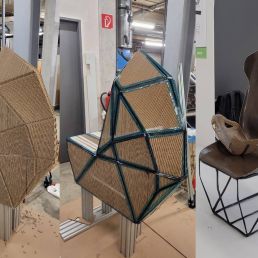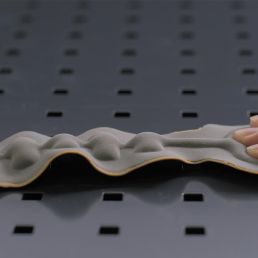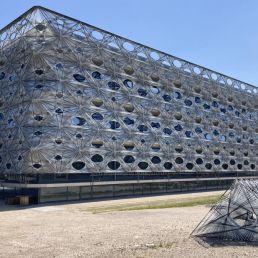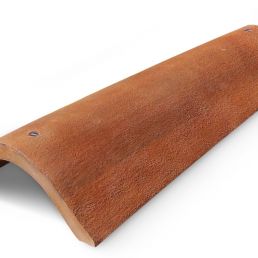
Luminoso
Translucent wood
10 August 2010
Not only glass and optical plastics such as polycarbonate or PMMA are permeable to light rays, but also stone and wood. After experimenting with glass fibers in Japan a few decades ago in order to make actually opaque and unwieldy materials such as concrete transparent, functional offers have appeared on the market in recent years. It all started with translucent concrete by the Hungarian architect Áron Losonczi, which he developed at the Stockholm School of Art.
Translucent room dividers or projection surfaces
In 2009 the principle of transporting light radiation over a greater distance by integrating optical fibers into a mass of material was then transferred to wood. Luminoso is the name of a translucent wood-based material that is used in interior design as a transparent room divider or projection surface. During production, PMMA fibers are glued in layers between thin wooden panels, creating a completely new composite material. The material transports light from one side to the other. The finishing is also easy. Whether painting or staining, the material is suitable for the application of all wood-compatible systems.
In the case of backlights with daylight or LED, the material allows light and direct sunlight to pass through. Objects, images and shapes that are placed between the light source and the material block the light and become plays of shadows. In this way, a film and graphics made in the cutting plot and glued behind can be displayed. A particularly interesting design option is to place the material in front of an LED screen so that moving images can be seen in color.
image: Luminoso
Ecoblaq molecular wood colours
23 March 2024
Ecoblaq is a molecule manipulation method, a natural chemical reaction, making…
Natural fiber reinforced car seat
22 October 2023
The focus of the project "Design for Recycling" is a seat shell that is made…
MotorSkins morphing textiles
19 April 2022
Berlin based start-up MotorSkins designs and produces textiles with embedded…
3D Pioneers Challenge 2022
15 December 2021
The 3D Pioneers Challenge 2022 adresses tech pioneers who pave the way for…
IGNIS – Light from waste heat energy
12 August 2020
The availability of affordable, independent and, above all, clean electrical…
Brake disc with reduced fine dust
21 April 2021
Fine dust endangers our health. One of the main sources is traffic, especially…
Texoversum
15 July 2023
With the "Texoversum", Reutlingen University has put into operation a training…
Invisible Terracotta Solar Rooftile
10 May 2023
The family-run business Dyaqua has developed a technology to integrate a…
Xarvio – Digital Farming
8 January 2021
BASF Digital Farming GmbH has received the renowned Crop Science Award for the…








